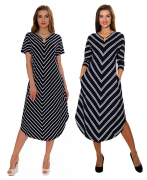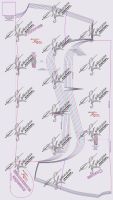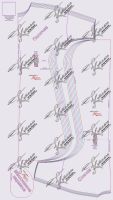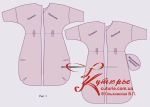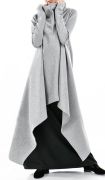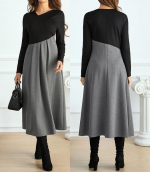Size charts What is the height of the pattern Payment methods Ask a question Reviews
Free download Instructions on how to sew to the pattern of this dress...
Instructions on how to sew a trapeze dress with a one-piece sleeve for an oblique cut to simple patterns - cutting and sewing at home
- Description of patterns.
- A complete set of patterns for a kimono dress-trapeze.
- Description of the design of varieties of dress style.
- What to sew a kimono trapeze dress from.
- How to buy and download ready-made patterns.
- How to cut a kimono trapeze dress according to a finished pattern.
- How to sew a dress according to this pattern.
Buy and download this dress pattern
1. Description of patterns
Simple patterns of an A-line dress with a one-piece sleeve for an oblique cut. Sizes: 40-52 and 52-64.
File format: PDF full size and without seam allowances
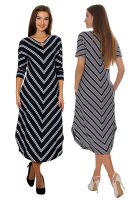 After paying for the order, you will receive links to download two files a-line dresses with a kimono sleeve for a slant cut, gradation of sizes from 40 to 52 and from 52 to 64:
After paying for the order, you will receive links to download two files a-line dresses with a kimono sleeve for a slant cut, gradation of sizes from 40 to 52 and from 52 to 64:
- PDF file A4, adapted for printing patterns on sheets of A4 paper in any program on any device, including mobile phones.
- Multi-format PDF file for printing on sheets of any size from A0 to A4 on a printer or plotter using Adobe Reader.
The level of sewing difficulty is easy for plain fabrics and medium for striped, plaid or coupon fabrics.
The style is suitable for most figures of various fullness and height.
The pattern is designed for sewing at home on household sewing machines.
For sewing, you will need a household overlocker with the ability to adjust the knitted seam and a machine with an adjustable zigzag. The stitching machine can be replaced with a double needle.
How to set up an overlock and sew knitwear
2. Complete set of patterns for a kimono trapeze dress
- Pattern of the back for a style with darts on the skirt (trapeze-balloon, as in the photo).
- Shelf pattern for a style with tucks on a skirt (trapeze-balloon, as in the photo).
- Backrest pattern for a style with an A-line skirt (without darts).
- Shelf pattern for a style with an A-line skirt (without darts).
- Burlap pattern for processing a pocket in the side seams.
3. Description of the design of varieties of dress styles
The lower part, the skirt of this dress has a shape that can conditionally be called a trapezoid. The bottom of the skirt is rounded, as is done in some shirts.
This is a concise style that can be done in two main variations:
- with a trapeze-balloon skirt with darts emphasizing the shape of a "balloon-trapeze";
- with an A-line skirt with rounded corners.
Soft pleats are marked on each pattern at the waist, which can be processed if a more fitted silhouette is needed or if the dress will be worn with a wide belt. This is a convenient alternative to tucks.
It is also worth paying attention to the middle seam of the shelf. It will allow for a finer fit for figures with a large difference between the bust and waist.
The patterns have short sleeve markings.
4. What to sew a kimono trapeze dress from
Any thin knitted stretch fabric with medium to high stretch will do.
You can consider both dress knitwear and cooler fabric, which is used for sewing T-shirts.
You can choose among striped stretch fabrics, plaid and coupon knitwear.
The consumption of fabric for a cut with a share coinciding with the middle line (Fig. 2, for plain fabrics and a wide coupon), with a width of 150 cm, will be from 150 to 240 cm.
The consumption of fabric for a bias cut (as in the photo) will be from 240 to 300 cm. This is a net expense, but to successfully combine the stripes, you should collect fabrics 30 cm more.
For a slant cut on coupon fabrics, it is recommended to do the layout right in the store, having previously chosen the length of the sleeve.
5. How to buy and download ready-made patterns
How to choose a size without using tables and taking measurements
What height are the patterns for?
How to buy a ready-made electronic pattern
How to print a pattern at home in full size on A4 sheets or on sheets of any other size
How to assemble a pattern after printing
Simple patterns for dresses, sweatshirts, skirts and trousers in full size Free
Buy and download this dress pattern
6. How to cut a kimono a-line dress according to a finished pattern
It is better to shorten or lengthen the pattern in the waist area - a fold on the pattern or a cut and extension when cutting.
If we are talking about a cut in which the middle lines of the back and shelves coincide with the shared thread (picture 2), then the layouts are very simple and do not require any explanation.
No seam allowances are needed either.
Cutting from fabric into stripes adds complexity and obliges to observe only one point (picture 3): the pocket points (or waist points) on the side seams must fall on the same point on the pattern of the fabric, the points of the notches before rounding (they are marked on the drawings) must fall on the (different) same point. On the 3 drawing these points are marked with crosses.
 For example, red crosses should fall on the bottom edge of the strip, and blue ones should fall on the middle of the strip.
For example, red crosses should fall on the bottom edge of the strip, and blue ones should fall on the middle of the strip.
How to achieve this?
- We start by spreading the fabric in one layer and laying out the shelf and back on it.
- We check the coincidence of the main points.
- Cut out one shelf.
- Then, you can fold the fabric in half or not fold it, but in any case, we cut out the second one along the first shelf, having previously achieved the best match of the strips.
- We lay the backrest pattern on the fabric and next to it the cut-out details of the shelf, achieving the best match of the stripes.
- We cut out one piece of the back.
- On the cut out part of the back, cut out the second part of the back.
- We cut out a transverse strip of fabric with a width of 2,5 - 4 cm for processing the neck.
- Finally, you should mark the folds, if necessary and be sure to make all the notches that are indicated in the drawing.
7. How to sew a dress according to this pattern
- Set up a knitted seam on an overlock and a narrow zigzag on a typewriter. The optimal narrow zigzag stitch values for stretch sewing should be written down or memorized so that you can change the settings.
- If pleats at the waist and / or darts on the skirt are provided, then they can be processed immediately. Stitch with a narrow zigzag or straight stitch and iron.
- The middle seam of the back is sewn on an overlock with a knitted seam and ironed.
- The middle seam of the shelf for a more convenient processing of the neck, if it is like in the photo, it is better to stitch it with a narrow zigzag and, having overcast each allowance separately, iron it. We start the line down from the neckline by 5 cm.
- Stitch the shoulder seams on an overlocker, placing a transverse strip of a thin cooler 2 cm wide under the seam. Then, iron.
- Stitch the burlap, attaching to the points of the pockets in which you made the notches. Iron.
- Sew the side seams on the overlock to the notch before rounding the bottom. It is more convenient to grind the side seams with a narrow zigzag and, having overcast each allowance separately with the transition to the bottom of the dress, iron it.
- Processing the bottom into a hem with an open cut. It has already been swept over, it remains to bend it once. The stitch can be done with a double needle or a wide zigzag.
- The bottom of the sleeve is also in a hem with an open cut.
- The neck is processed with a transverse inlay. The inlay is ironed in half lengthwise, trimmed and sewn to the neckline on an overlocker. Then, the seam is folded over and sewn off. On the "face" you can see a very narrow strip of inlay - 0,2 - 0,5 cm. The ends of the inlay are hidden under metal fittings (bead or tube) or play the role of decorative ties.
Download this pattern pdf:
Simple patterns for a one-piece sleeve A-line dress for an oblique cut
$2.00 (80 hryvnia)
Bank cards of the Russian Federation are not accepted for payment!
Size charts What is the height of the pattern Payment methods Ask a question Reviews
Vera Olkhovskaya in social networks:

See similar clothing patterns and how to sew on them
-
Any pattern for free for a review of a previously made order
More...
Lifetime promotion for buyers of patterns!

Leave a review about my store of patterns for an order that you made before, and you will receive any paid pattern of your choice Free!
